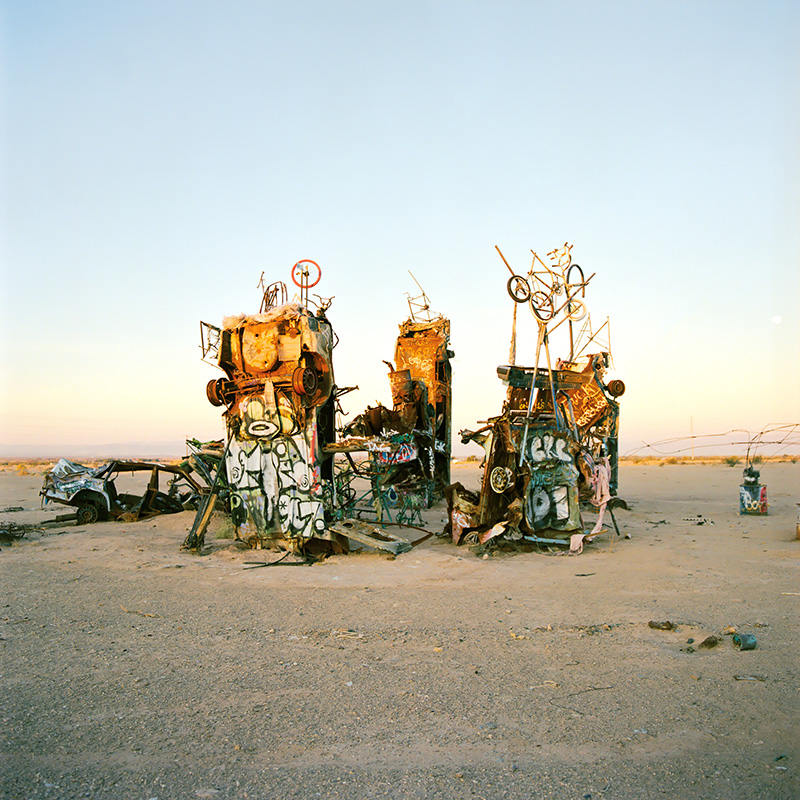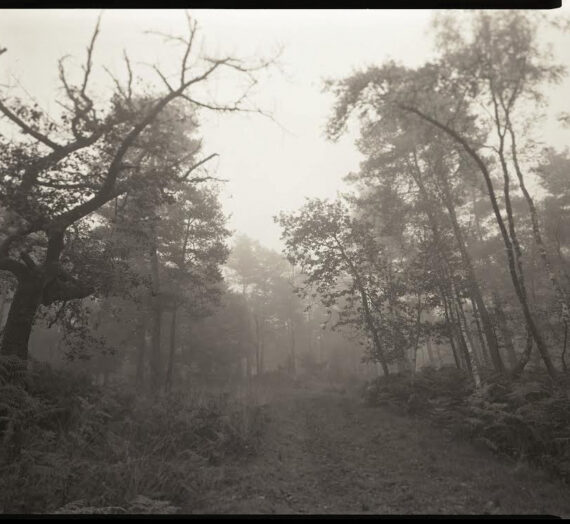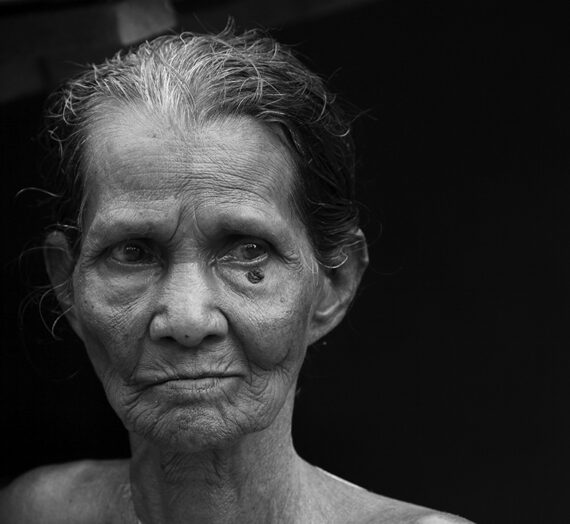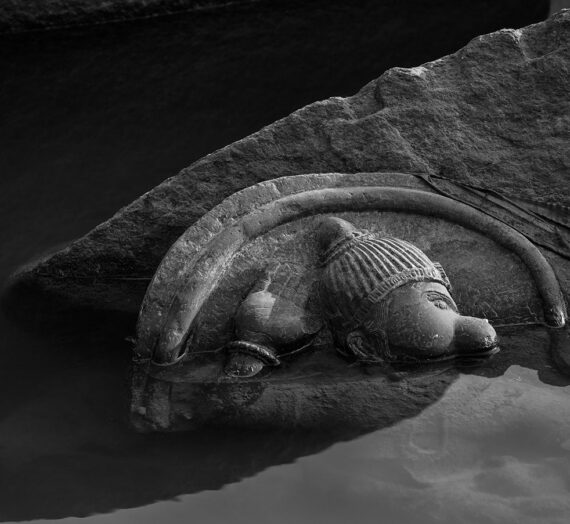‘Middle of Nowhere’
Daniel Skwarna
‘Middle of Nowhere’ is a photo-documentary about the squatter community of Slab City, near Niland, California, USA. The Slab city is home to some of the poorest people of the state with no official electricity, running water, sewers, toilets or trash pick-up service. Through the poignant images of some of the most downtrodden people in the United States, Mr.Skwarna makes a pictorial commentary about the living conditions, life-style and the temperament of the Slabbers. His portraits are direct, intimate as well as truthful.
Daniel Skwarna is a Toronto-based documentary photographer who has worked around the globe on various documentary and editorial projects. He holds a degree in Fine Art History from the University of Toronto. – Dr. Unni Pulikkal, Director, PhotoMuse.

Daniel Skwarna Writes:
If you drive south on Interstate CA-111 along the eastern shore of the Salton Sea, past Bombay Beach, Frink, Wister, Mundo and around the migrating geyser, you reach Niland, one of the poorest counties in California. Turn left at Main Street (Mae’s grocery), and head due east over the Southern Pacific railroad tracks, until Main becomes Beal Street access road. On any given day you might pass Cuervo, as tall and lean as a scarecrow, riding his mule to town. He likes eating cottage cheese with his index finger, Firebrand whiskey, Oxycontin, and Black Tar Heroin he buys cheap in Mexicali.


Just past the East High Line canal, you come to a sentry box painted in psychedelic colours by Noah Achram, an electrician’s apprentice-turned-artist from Detroit. Hop out and feel the searing desert heat that melts plastic. When it becomes too much, hop in Slab City’s shower, just a few feet away.
Super-heated water from the natural hot spring (it sits on the San Andreas fault) about a mile north flows stream-like through a canopy of Palo Verde and Creosote, cooling about forty degrees until it drops into an eight-foot deep concrete box. Look for the ladder poking above the shower line and chill out. This area used to be shady and idyllic (for the desert) until a Slabber burned it down.


Ahead on your left, you’ll start seeing camps. In late spring small rocks and soup cans rough out camp boundaries. Most are too late in the season to become proper shelter before the heat arrives. Nearby, several recreational vehicles sit stolidly, out of place. Like birds late to migration, their owners will soon flee the heat in their air-conditioned rolling homes, returning to Babylon (city life) and cooler weather in the north. They’ll be back in November with winter.
Towering over all of this is Salvation Mountain. In a certain light (best early morning or late day), Leonard Knights’ fifty-foot-tall adobe hillside is Slab City’s salvation, bringing thousands of tourists and their dollars through to East Jesus, the art colony created by Charlie Russell (Container Charlie). Knight started building in 1984 and spent the rest of his life rebuilding his colourful, cartoonish dedication to God after it collapsed in 1990.


Between Salvation Mountain and East Jesus, lies Slab City proper. When you arrive at the second sentry box, you’re in The Slabs. Welcome to the Last Free Place! You’re entering a 640-acre plot of California desert within the Salton Sink, a northwestern landward continuation of the rift that extends 140 miles northwest from the head of the Gulf of California.
Slab City sits on the leftover infrastructure of Camp Dunlap, a WWII marine base activated in 1942 as a training camp for action in North Africa. The base also provided training areas for army troops under General Patton, a bombing range for planes from a nearby Marine Air Station, and a staging area for smaller Marine groups. It was deactivated in 1945. When the land was returned to the State, only the concrete slab foundations remained to float on the shifting sands.


Slabbers have been shifting with these sand for decades; building, scrapping, repurposing, surviving, dying. They’re a motley crew, as varied as anywhere else. The year-round population is modest. Roughy fifty stay through July and August when temperatures are mercurial and even rattlesnakes seek the shade of campers.
Their ability to endure inhuman conditions year after year is matched only by a shared distaste for the gridded boilerplate of city life. Many are on SSI, SSDI, or just plain broke. Modern American pioneers, claiming their slab and declaring themselves master. A free range society of feral folks occupying a chunk of desert in Southern California.


Slabbers have different reasons for coming here and staying. Many are transient, coming for the warmth in winter. Some seek anonymity, others to forego the rat race. Veterans with PTSD neighbour hippies, meth heads, and Oxycontin addicts. Survivalists and religious men come to the desert to test themselves as their forefathers have for millennia. Felons hide deep in the Slabs under cover of creosote to evade the authorities. Average American families that never recovered from the Great Recession or want to stretch their retirement funds. Artists, musicians, philosophers.


Few of them enjoy the conveniences we take for granted. There is no free drinkable water, no tap to turn. Slabbers can filter the East High Line canal, brown with farm runoff, or take from the faster moving Coachella Canal feeding Palm Springs and Los Angeles. Otherwise, you pay local suppliers. Garbage is either kept by Slabbers (for future reuse) or dumped for lack of municipal pick-up. Solar panels and deep cycle batteries provide power to run fans and swamp coolers in the hottest months. Sanitation varies from rvs to composting toilets and gopher holes. To each his own. There is a cost to living free.


Local businesses have sprung up creating a small local economy, as tenacious as Creosote. Airbnbs and hostels for tourists, water-tank installation and delivery services, solar panels from Solar Mike, and Slab cabs to the Walmart in Brawley. RabbitSide, located right up against the Coachella Canal describes itself as an experimental off-grid micro farm created out of recycled, free, and thrifted materials. Business-minded Slabbers like Jack Two Horses ask Niland locals to dump their unwanted furniture and electronics, then sell it off in bulk to neighbours.


Camps range from desert comfort to simple A-frames made of cardboard and solar panel pallets. There are Slabbers in WWII bunkers, recreational vehicles (they vary in quality and comfort), hostels, the Christian Centre, water cisterns, school buses, and underground. Prime Space within the Slabs is scarce and built-up camps are often sold when people leave for the city. Some Slabbers are imprisoned by their freedom, unable to leave their camps for long, afraid of petty thieves and camp usurpers. Housebreakers creep camps under the cover of darkness, stealing to feed their addiction.


Without a grid to orient you, nothing is certain in the desert. A flash flood in the backcountry can throw a camp into disarray, mattresses tossed hundreds of feet, upended in the dirt. Friends and neighbours offset the vicissitudes of desert living. Mojo’s camp offers free clothes and water. The Internet Cafe dispenses free coffee and WI-FI. The Oasis Club provides mail service for anyone without a P.O box in nearby Niland and a five dollar Sunday breakfast (eggs, french toast, hash browns, fruit salad, and coffee).


Behind the Oasis, the Wayside Inn hosts a weekly fish fry and daily meals. The library is a well-stocked and welcome respite from the heat and comes with a bar. Every third Wednesday of the month, the Niland Chamber of Commerce hands out basics: rice, peanut butter, etc. On Saturday night, Slabbers converge on Builder Bill’s Range to catch up and listen to live music late into the night. Camp Dunlap’s former pool is now a skateboard park and camp. All alone in your RV? The Loners on Wheels camp is your home away from home. On Sunday, jump in the canal with everyone else.


Live and let live rules the Slabs. Be neighbourly. Follow the ethics guide and do unto others. The point of freedom is to be free. Nonetheless, Slab City sits on school-board mandated state land, making some form of organized concern unavoidable. Economic and environmental factors favour Slabbers, many of whom have lived here for decades. Niland is one of the poorest counties in the state with high unemployment and few opportunities. Much of Niland’s economy depends on Slab City and the local markets that service it. Camp Dunlap and Slab City have both left and continue to leave significant waste, making clean-up costly, if not impossible. And the Slabs sit well within the circle of a dangerous ecological disaster – the Salton Sea.


As the sea evaporates and recedes it exposes thousands of acres of toxic sediment to hot, dry winds. Salton mud contains arsenic, selenium, chromium, zinc, lead, and pesticides like DDT. A serious health crisis is right now affecting children following decades of water diversion and political inaction. Niland and the surrounding region has some of the worst air pollution in the country. Imperial County has the highest rate of asthma-related emergency room visits for children in the state. It’s hard to see this small patch of far-flung desert as a mecca for development.


In 2015, the CSLC issued several reports, including the Proposed Sale of School Lands in Imperial County. It included three organizations interested in purchasing small parcels of land within Slab City proper. Salvation Mountain Inc. to purchase the southwest quarter (160 acres), including Salvation Mountain. The Chasterus Foundation to purchase thirty acres that encompass and expands East Jesus, Charlie Russell’s upcycled outdoor art gallery.
Lastly, the Slab City Community Group, a non-profit made up of some, but not all, members of Slab City. According to the report, the potential sale of the Slab City parcel is subject to future environmental analysis and review of potential renewable energy resources (geothermal and solar) in the area.
That was four years ago and no such environmental analysis has happened. For the people who call the Slabs home, the Last Free Place will likely remain just that for the foreseeable future.
Daniel Skwarna, 2020





Leave a Reply